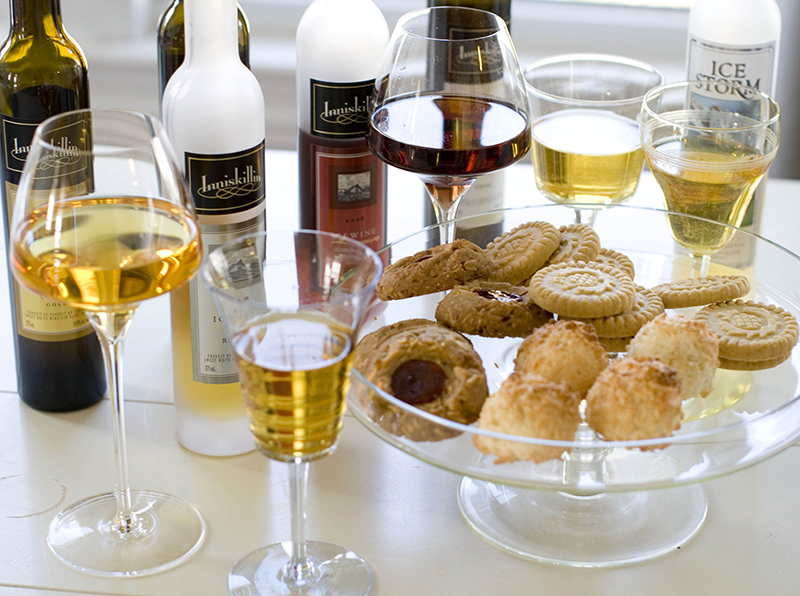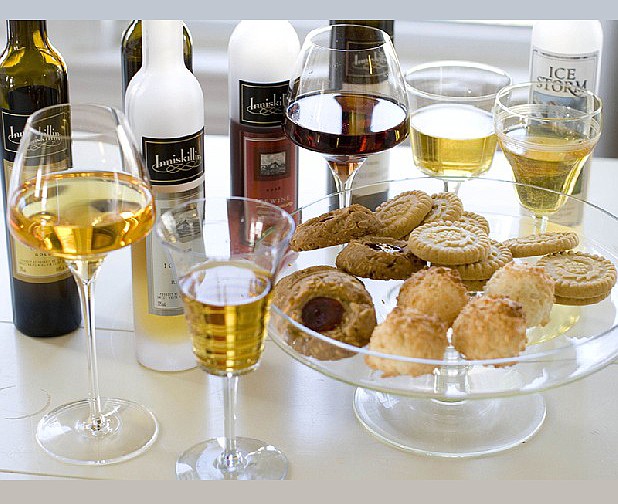Ice wines a cool choice for holidays
Wednesday, November 27, 2013
 From left, Inniskillin's 2007 Vidal Gold, 2008 Riesling, 2008 Cabernet Franc, and Ice Storm's Vault Reserve ice wines. Leaving grapes to freeze on the vine seems like a recipe for stone cold failure. But under the right conditions, the grapes that come in from the cold can produce delicious dessert wines that are a cool favorite for holiday pairings.
From left, Inniskillin's 2007 Vidal Gold, 2008 Riesling, 2008 Cabernet Franc, and Ice Storm's Vault Reserve ice wines. Leaving grapes to freeze on the vine seems like a recipe for stone cold failure. But under the right conditions, the grapes that come in from the cold can produce delicious dessert wines that are a cool favorite for holiday pairings.Leaving grapes to freeze on the vine seems like a recipe for stone cold failure. But under the right conditions, the grapes that come in from the (extreme) cold can produce delicious dessert wines that are a cool favorite for holiday pairings.
What to call it? It depends on where you are. It's called eiswein in Austria and Germany, where it began; icewine, one word, in Canada, where it's become something of a signature wine; and ice wine, two words, in the United States, where vintners in New York state and few other regions are experimenting with the hard-to-make, easy-to-drink product.
Whatever you call it, interest in the wine is heating up as producers experiment with new grapes and new winemaking styles - how about some sparkling ice wine with those gingerbread men?
"The icewine category in Canada is continuing to evolve with new and innovative products entering the market each vintage," says Franco Timpano, director of marketing for Inniskillin, a leading producer of ice wine, selling roughly 5,000 9-liter cases annually in Canada and about the same amount in the United States. We're seeing icewines made from varieties that we haven't typically seen."
Typically, ice wines are made from riesling and cabernet franc, as well as Vidal, a winter-hardy French-American white hybrid grape developed by Jean Louis Vidal in the 1930s. But lately, Timpano's been seeing ice wines made from merlot, sauvignon blanc and cabernet sauvignon. Inniskillin has made a sparkling Vidal icewine and this year came out with a sparkling cabernet franc icewine available mostly in Canada and at duty-free stores.
Making ice wine is not for the faint of heart, points out Steve DiFrancesco, winemaker at Glenora Wine Cellars and Knapp Winery and Vineyards in New York's Finger Lakes wine-growing region.
First, the grapes are left on the vine for months after regular harvest is over. The leaves are gone and vines are dormant, providing little protection, and though the grapes are bundled in netting to ward off the advances of nature winged and clawed, they are still vulnerable. The benefit to all this grape hardship is that the sugars and other dissolved solids don't freeze, but the water in the grape does, which means when the frozen grapes are pressed they produce a more concentrated, sweeter juice.
DiFrancesco likes to pick at around a chilly 13 degrees Fahrenheit. He's also made wines with grapes frozen post-harvest. Wines made that way can't be labeled as "ice wine" in the U.S. or Canada; though they may have the word "iced" on the label. DiFrancesco labels his as frozen post-harvest to make things clear. Wines from artificially frozen grapes are a technically sound product, while naturally frozen wines have more richness and depth, but possibly more funkiness, too, he says, which he doesn't see as a bad thing. "It's like people, if they're too perfect, they're not interesting."
In terms of holiday dessert pairings, texture's important, says Patrick Cappiello, partner and beverage director of Pearl & Ash, a Bowery hotspot in New York. Something firm is required to balance the syrupy nature of the wines. Gingerbread is "kind of a no-brainer," and another choice might be crisp oatmeal raisin cookies.
"The thing that's cool about ice wine is there's a textural difference that you don't see with other wines, and you see the care - the fact that there's so many steps, there's so much effort that goes into making it," says Cappiello.
